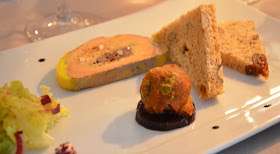On Monday, September 3rd, MonacoUSA will lay a memorial wreath to
commemorate the American Liberation of Monaco from German occupation 68 years
ago. The ceremony begins at 4 pm in the cemetery in Monaco, located just below
the Princess Grace Hospital. Among the groups that will be represented
are the American Club of the Riviera,
the American Legion, MonacoUSA and the Monaco Ambassadors Club.
After the ceremony, there will be an informal get-together at Stars and Bars on the Port. Everyone
is welcome.
Prince Albert II has also
planned a commemorative celebration, this one in and around the Palace. An exhibition in the Palace courtyard will
showcase vehicles, weapons, clothing and other unique wartime items. It will
run for two days (Sunday and Monday) and entry is free. On Sunday September 2nd, there will be a gala ball from
5 pm to midnight, with a jazz swing band and free entry.
On Monday, there will be parade through Monaco, starting
at 10:30 am on the Place du Palais (I'm told 10:30 although the poster above says 11 am). The parade will travel through Monte Carlo
and finish at the Maison de France, where a wreath will be laid.
Monaco was liberated by Allied Forces on September 3rd,
1944. The Principality had been occupied
by the Nazis for a year, during which many of its Jewish residents were
deported to concentration camps in Germany. So much
attention is focused on the Normandy landings that history has almost forgotten
how a southern offensive on the German-occupied Riviera not only led to the
liberation of its many citizens, but also opened what was to be a crucial
supply line from the Mediterranean to the Allies, as they approached Berlin.
Thanks to CityOut Monaco for
this historical information:
After the mass landing of Allied assault craft along the coast west of Nice on August 15, 1944 came the allied aerial bombardments of August 27 and 28, which badly damaged the port area of Monaco. Five days later, the naval battering of La Turbie and Mont Agel signaled the moment for the German troops to depart. On September 3rd, the 517th Parachute Regimental Combat Team, attached to the 36th US Infantry Division, arrived in Monaco.
After the mass landing of Allied assault craft along the coast west of Nice on August 15, 1944 came the allied aerial bombardments of August 27 and 28, which badly damaged the port area of Monaco. Five days later, the naval battering of La Turbie and Mont Agel signaled the moment for the German troops to depart. On September 3rd, the 517th Parachute Regimental Combat Team, attached to the 36th US Infantry Division, arrived in Monaco.
According to one popular story, a jeep with two American GI's came
racing down the road from Menton. The jeep drove into Monte Carlo and pulled up
to the Tip Top Bar, where one of the
GIs, the future-author Irwin Shaw,
jumped out, ordered some drinks and announced that Monaco had been liberated.
In no time at all, crowds of Monegasques were crowding around the Americans to
express their thanks.
Later, more Allied troops arrived for formal ceremonies, which were presided
over by a proud Prince Louis II and his grandson (and fellow French army
veteran), Prince Rainier.
With the eloquence and political aplomb of a future statesman, the
young Prince Rainier said "Now, more than ever, Monaco should be considered
a sovereign, independent and neutral state. If the Allies should require a
guarantee, I give them that guarantee..."





__photo_Jones.jpg)
.JPG)

__%250d%250a+hillside_view_photo%250d%250a+__Jones.jpg)

















.JPG)




.JPG)





